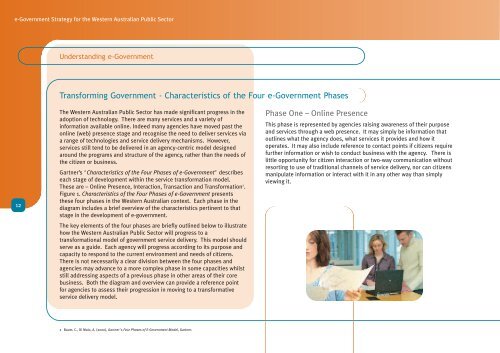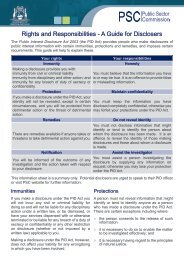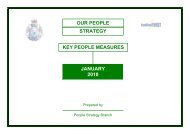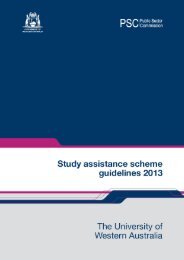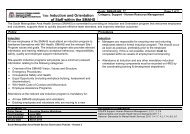Archived document - Public Sector Commission - The Western ...
Archived document - Public Sector Commission - The Western ...
Archived document - Public Sector Commission - The Western ...
Create successful ePaper yourself
Turn your PDF publications into a flip-book with our unique Google optimized e-Paper software.
e-Government Strategy for the <strong>Western</strong> Australian <strong>Public</strong> <strong>Sector</strong><br />
Understanding e-Government<br />
Transforming Government - Characteristics of the Four e-Government Phases<br />
12<br />
<strong>The</strong> <strong>Western</strong> Australian <strong>Public</strong> <strong>Sector</strong> has made significant progress in the<br />
adoption of technology. <strong>The</strong>re are many services and a variety of<br />
information available online. Indeed many agencies have moved past the<br />
online (web) presence stage and recognise the need to deliver services via<br />
a range of technologies and service delivery mechanisms. However,<br />
services still tend to be delivered in an agency-centric model designed<br />
around the programs and structure of the agency, rather than the needs of<br />
the citizen or business.<br />
Gartner’s ‘Characteristics of the Four Phases of e-Government’ describes<br />
each stage of development within the service transformation model.<br />
<strong>The</strong>se are – Online Presence, Interaction, Transaction and Transformation 2 .<br />
Figure 1. Characteristics of the Four Phases of e-Government presents<br />
these four phases in the <strong>Western</strong> Australian context. Each phase in the<br />
diagram includes a brief overview of the characteristics pertinent to that<br />
stage in the development of e-government.<br />
<strong>The</strong> key elements of the four phases are briefly outlined below to illustrate<br />
how the <strong>Western</strong> Australian <strong>Public</strong> <strong>Sector</strong> will progress to a<br />
transformational model of government service delivery. This model should<br />
serve as a guide. Each agency will progress according to its purpose and<br />
capacity to respond to the current environment and needs of citizens.<br />
<strong>The</strong>re is not necessarily a clear division between the four phases and<br />
agencies may advance to a more complex phase in some capacities whilst<br />
still addressing aspects of a previous phase in other areas of their core<br />
business. Both the diagram and overview can provide a reference point<br />
for agencies to assess their progression in moving to a transformative<br />
service delivery model.<br />
Phase One – Online Presence<br />
This phase is represented by agencies raising awareness of their purpose<br />
and services through a web presence. It may simply be information that<br />
outlines what the agency does, what services it provides and how it<br />
operates. It may also include reference to contact points if citizens require<br />
further information or wish to conduct business with the agency. <strong>The</strong>re is<br />
little opportunity for citizen interaction or two-way communication without<br />
resorting to use of traditional channels of service delivery, nor can citizens<br />
manipulate information or interact with it in any other way than simply<br />
viewing it.<br />
2 Baum, C., Di Maio, A. (2000), Gartner’s Four Phases of E-Government Model, Gartner.


